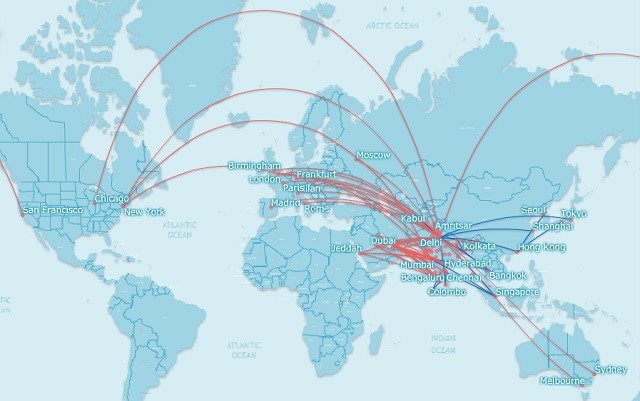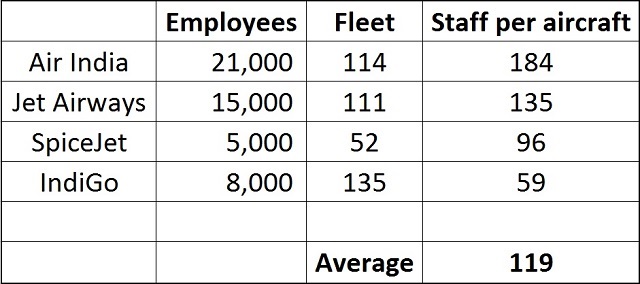After years of debate and deliberation, the Indian government appears to have reached the stunning revelation that it is not all that good at running an airline.
In a recent television interview, finance minister Arun Jaitley explained that state-owned Air India should pursue privatisation, given that the majority of its domestic competitors "are already privately owned". He did not say what percentage of the airline would be up for sale.
"There is no reason why the government should be running an airline," he said. "If we do not divest now, there will be nothing left to divest."
Meanwhile, India's national policy think-tank, the National Institution for Transforming India, has called for a complete privatisation.
Despite having the status of a national carrier, Air India's domestic market share is only 13-14%, according to Jaitley. It has failed to keep up with the likes of IndiGo, SpiceJet and Jet Airways. To make matters worse, Air India is saddled with an accumulated debt of Rs550 billion ($7.7 billion).
Jaitley says half of this debt is "related to aircraft valuation" and that its aircraft "are still assets that could be sold".
AIR INDIA'S ATTRACTION
In spite of its financial woes, Air India does have a few things that could entice investors.
First, the carrier possesses a ready fleet of aircraft for immediate operations. Flight Fleets Analyzer shows that among India-based carriers, Air India's fleet of 114 aircraft is second only to low-cost behemoth IndiGo, with 135 Airbus A320s.
Two-thirds of Air India's fleet are of the A320-family. It also has 15 Boeing 777s and 23 787s. Around 15% of the aircraft are 20 years or older, but the rest are no older than 11 years.
Air India also has the largest international network among competitors. Data from FlightMaps Analytics shows that Air India operates to 28 international points, against its nearest full-service rival Jet Airways with 12 international points.
Air India's International Network, June 2017

FlightMaps Analytics
Being an arm of the government confers some benefits as well. The Star Alliance carrier has found it relatively easier to get good slots at key major airports, especially at those operated by the Airports Authority of India and at congested airports.
TWO BALANCE SHEETS
In a televised debate, former executive director of Air India and author of author of The Descent of Air India, Jitender Bhargava, says privatisation "should have been done 25 years ago". He disagrees with the government for speaking about the difficulties of finding an investor for the carrier.
"We should highlight the positives of Air India: its international standing, its ground handling business and real estate [assets]. Being a public sector company, Air India bears the burden of having many cost sectors. You cannot compare Air India's balance sheet with that of Jet Airways and IndiGo."
Bhargava recommends that New Delhi "create two balance sheets" for the carrier, and ultimately be responsible for compensating Air India. The first should document "all the social support that Air India performs on behalf of the government, especially for personal gain at the cost of the airline".
The second list would look at past government decisions affecting the carrier, from large aircraft orders, to its 2007 merger with Indian Airlines, as well as the routes it flew that were difficult to recover even operational costs.
"The government should compensate Air India to the extent of losses caused by its decisions or systems," adds Bhargava. "Once [New Delhi] has divided the two, [New Delhi] has a moral right to tell the carrier that the country cannot be writing off its debt for all time to come. [Air India] has got to be on [its] legs… if not, so be it."
PASS ON THE ASSETS
Amber Dubey, India head of aerospace and defence at KPMG, says the best option in the privatisation process is "segregating the assets and liabilities".
He explains that New Delhi should keep the liabilities in the Air India balance sheet and pass on the assets to a Special Purpose Vehicle (SPV).
"In that newly formed SPV, you can give 74 to 100% equity to a private operator on a global competitive bidding basis. There are significant assets that the airline has, in terms of its aircraft; slots at key major airports in India and overseas, real estate, as well as its subsidiaries."
A key decision that the Indian government would have to make would be whether to sell off Air India's subsidiaries and use the proceeds to clear some debt. Dubey also questions if the government could have kept Air India and Indian Airlines separate.
"Should we have unbundled them and then sell them separately? Sometimes the sum of parts could be easier to absorb, hence make it easier to bid for and then we might get a higher realisation of the company."
POTENTIAL ROADBLOCKS
However, the path to Air India's privatisation will not be smooth. In fact, New Delhi has already hit a roadblock. The country's Central Bureau of Investigation (CBI) is investigating a decade-old aircraft deal in which Air India and the former Indian Airlines ordered 111 aircraft, apparently prompting massive losses for the airlines.
The CBI said the ministry of civil aviation, Air India and "private persons" are under investigation "for costing about Rs700 billion ($10.5 billion) to benefit foreign aircraft manufacturers".
"Such a purchase caused an alleged financial loss to the already stressed national carriers," added the bureau.
In 2007, Air India ordered 68 Boeing aircraft, comprising eight 777-200LRs, 15 777-300ERs and 27 787s for its own operations, as well as 18 737-800s for low-cost subsidiary Air India Express. Indian, meanwhile, placed an order with Airbus for 43 aircraft comprising 19 A319s, four A320s and 20 A321s.
The CBI is also looking into allegations of the leasing of "a large number of aircraft without due consideration, proper route study and marketing or price strategy". CBI cited claims that the aircraft were leased "even while [the] aircraft acquisition programme was going on".
JOBS FOR ALL
The other major hurdle is the powerful employees' union. The Air Corporations Employees' Union (ACEU) has told local media it is "shocked and surprised... that the government is on the verge of taking a unilateral and arbitrary decision [to privatise Air India]".
The ACEU has also blamed previous governments for their "bungling and disastrous experiments" on the airline, and threatens to oppose the move.
Regardless of the merits of employees' gripes, they have one thing on their side: numbers. FlightGlobal data shows that Air India boasts the most bloated employee-to-aircraft ratio among listed India-based airlines. With a fleet size 15% larger than Air India, IndiGo has less than half has many staff. For every aircraft, Air India employs 184, while IndiGo employs just 59.
Although the government is probably well aware that Air India is severely overstaffed and unproductive, it may be reluctant to raise the ire of vocal unionists – particularly given its heavy involvement across a number of industries.
India-based airlines' staff per aircraft

FlightGlobal
INDIA NOT ALONE
Despite all the hand-wringing around Air India, it can look to history for evidence of successful airline privatisations. British Airways, Air New Zealand and Lufthansa were all formerly state-owned. Though they have had their share of difficulties, they are generally successful in the current climate.
"State-owned airlines are an anachronism in a liberalised air transport market," said Matthias Wissmann, former German minister of transport in an interview with The Independent newspaper. "As competition becomes increasingly fierce throughout the world, a successful airline needs as much entrepreneurial scope as possible."
Source: Cirium Dashboard














![[Photo] Korean Air K-UAM](https://d3lcr32v2pp4l1.cloudfront.net/Pictures/100x67/7/3/1/101731_photokoreanairkuam_478072.jpg)




